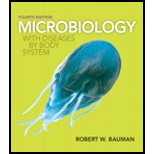
Concept explainers
To answer:
Distinguish between filamentous
Introduction:
Fungi are unicellular/ multicellular or multinucleate organisms having filamentous structures called hyphae. Fungi are eukaryotes with the heterotrophic mode of nutrition. Vegetative growth of fungi takes place with the help of hyphae. Algae are unicellular to multicellular prokaryotic organisms. Mode of nutrition in algae is autotrophs but some of the green algae, brown algae (dinoflagellates) have become heterotrophs (colorless algae). Algae and fungi have a cell wall containing cellulose and chitin as their characteristic structures.
Trending nowThis is a popular solution!

Chapter 12 Solutions
Modified MasteringMicrobiology with Pearson eText -- Standalone Access Card -- for Microbiology with Diseases by Body System (4th Edition)
- Hyphae that are divided into compartments by cross walls are called septate hyphae. True or false?arrow_forwardWhy are lichens so sensitive to air pollution?arrow_forwardLichen-forming fungi are generally capable of reproducing by the production of ascospores: single-celled reproductive units small enough to be carried away on the air. What questions does this fact pose about the obligate / facultative nature of this mutualism?arrow_forward
- What are number of nuclei present in fungus?arrow_forwardWhat form of lichen is this ?arrow_forwardIn the following diagram of a black bread mold (Rhizopus stolonifer), identify the following structures of a multicellular fungus: mycelium, rhizoids, stolon, sporangium, sporangiophore, sporangiospores. Note: Sample fungus herein is not found in aquatic environment. Rhizopus stolonifer is a common agent of decomposition of stored foods; they are terrestrial in habitat.arrow_forward
- How would you classify this paramecium: animal-like, plant-like, or fungus-like. Why?arrow_forwardIs each of the following haploid, diploid, or dikaryotic: basidiocarp, basidiospore, primary mycelium, zygote, secondary mycelium?arrow_forwardFungi tend to reproduce sexually when nutrients are limited or other conditions are unfavorable, but they reproduce asexually in more ideal conditions. Why is this strategy successful? Please add a reference website, and an example if possiblearrow_forward
 Biology: The Dynamic Science (MindTap Course List)BiologyISBN:9781305389892Author:Peter J. Russell, Paul E. Hertz, Beverly McMillanPublisher:Cengage Learning
Biology: The Dynamic Science (MindTap Course List)BiologyISBN:9781305389892Author:Peter J. Russell, Paul E. Hertz, Beverly McMillanPublisher:Cengage Learning
